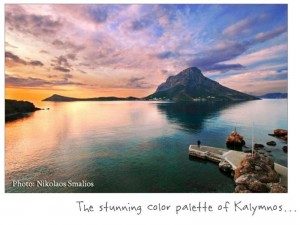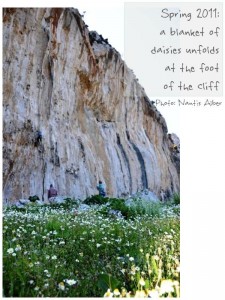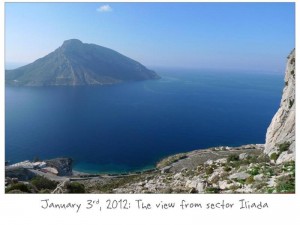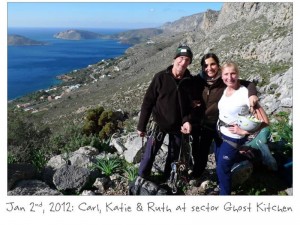
As climbing on Kalymnos continues to grow, so does the need to protect and improve it. We recently shared some thoughts about Kalymnos on 8a.nu. Among other things we discuss our hopes and suggestions for the future, from the imminent (more maintenance of routes, the need for a rescue team etc) to the less pressing needs (climbers’ info point, maintenance of footpaths). The full interview is reprinted below. As always, feel free to send us your own comments and suggestions on how to improve the Kalymnos climbing experience.
(Source: 8a.nu, January 20th, 2012)
Aris Theodoropoulos aka Mr Kalymnos gives us the story of how Kalymnos became the most popular climbing destination in the world. He also gives some thoughts on how the future development can be secured.
How and when did you first climb at Kalymnos and what was your reaction?
I first climbed there in 1999. But I’d heard about the potential of Kalymnos earlier, in 1995, when my friend Yiannis Torelis, one of the best Greek climbers from Patras, went to Kalymnos. He didn’t climb then, but he took some poorly-lit photos of the cliffs and showed them to me enthusiastically. In fact he was mesmerized by Grande Grotta and its stalactites! I was skeptical at first, because at the time I was mostly interested in multi-pitches and Kalymnos didn’t feature particularly long cliff faces. Yiannis went to Kalymnos again in 1998 with George Kopalides, another very good climber from northern Greece. Together they bolted the now famous Aegialis in Grande Grotta and a few more routes at sector Odyssey.

When I finally made it to Kalymnos in early 1999 and the cliffs were revealed before me, I was literally speechless. I climbed my first routes there and couldn’t believe the quality and sheer climbing possibilities of the island. I had never seen so many potential crags crowded next to each other competing for space! I lost myself in a climbing nirvana for a few days, and then realized I had to get in touch with the locals. I met with mayor Diakomichalis (who recently returned to office) and tried to explain the huge potential of Kalymnos as a climbing venue. I suggested a few things to better organize climbing and attract climbers. Even though the locals had never heard of climbing, they did their best to support this venture. Okay, at the time I never expected Kalymnos to top the list of best sport climbing venue in the world someday, or that I would become a ‘local’ and spend half my life there. But the climbing there kept growing, and last October a record-breaking number of climbers came to the island.
How did you get involved in the development and how have you taken part since then?
I basically got involved since my first visit back in 1999, by proposing a set of measures to the municipality and helping implement them. In our first actions to develop climbing, we established a standard for the equipping of routes (stainless steel bolts, clipable lower-offs with a chain and two bolts –most lower-offs at the time were on a single bolt); we printed route names discreetly at the base of each route in blue paint; we performed maintenance of the existing routes and equipped new routes; we established and marked the footpaths going to crags and put white markers at the starting point of each by the roadside; we secured a supply of hardware for equipping and maintenance; we started to promote Kalymnos as a climbing destination; we created an info point for climbers; and we created a detailed page on the internet with information about travel and the potential of the island (fellow climbers helped translate the webpage into five languages).
The following year (October 2000) we had the 1st international climbing festival on the island with the official participation of the legendary Catherine Destivelle. It was a great reward for our efforts. Approximately 180 climbers from 13 countries took part, and the island was buzzing with energy, ideas, and climbing. It was fantastic. That’s also when the first climbing guidebook was published. It was funded by the municipality and was distributed to all there for free. The festival really made a difference in that Kalymnos was now on the global ‘climbing map’.

Since then it has grown continuously. In numbers, between 5.000—7.000 climbers visit every year; there are about 2.100 routes at the moment, and more or less 200 new routes are added every year. As for me, I spend more and more time on the island. The last few years I have divided my time between Kalymnos and Athens. I continue to promote Kalymnos whenever and wherever I can and to help with the festivals. Besides climbing, I spend my time on Kalymnos equipping, locating new crags, doing maintenance of older routes. With constant pressuring, the municipality has agreed to fund the maintenance of 100 routes every two years. I do the maintenance with help from friends and colleagues, but I am still pressuring for more maintenance. It’s simply not enough – I get emails and handwritten notes (left for me at the climbing shops) all the time about a loose bolt here or a dangerous handhold there, and whenever I am on the island I make the repairs that have priority. I permanently have a stash of hardware and my drill ready for these jobs.

Also since then, my other Kalymnos project is the guidebook. Five editions have been made so far (2000, 2003, 2006, 2008 and 2010). I have done my best to create a book with a lot more than just the basic black-and-white photos and route sketches. I want to do justice to Kalymnos, and I think a more complete publication, with color photos –both action and lifestyle- and as much information as possible about crags and routes truly inspires and recreates the special vibe of Kalymnos. I also started the website climbkalymnos.com about two years ago; it features the latest info and news about Kalymnos, an e-shop for the guidebook, a forum and an interactive database of climbing routes (where people can also comment on routes). These are ongoing projects that require constant work, but I am lucky to have a great team of people helping me. We are very happy and proud that Kalymnos has become a favorite of the global climbing community even though nobody had ever heard of Kalymnos 12 years ago.
What do you think and hope for the future?
Well, I think the economic mess in Greece pretty much eliminates any possibility for municipal (or other government) funding towards maintenance of routes, rescue, festivals and so on. But what I hope is that the municipality realizes how vital climbing is to the island, and that it will do everything in its power to protect it, perhaps through some EU funding program. Climbing on Kalymnos has grown to a critical point, where no single individual can manage or supervise it. In my opinion, it is absolutely necessary to put together an official entity to manage climbing on Kalymnos. I have proposed this to the municipality in writing, along with everything that I believe must be attended to (very) soon:
– There must be an organized and well-staffed climbing info point in Masouri.
– There is no comprehensive official website with info for the visiting climbers; explore collaboration with climbkalymnos.com.
– There must be a screening process whereby all new route setters will be evaluated before bolting, based on their previous equipping experience, the hardware they propose to use and the crag where they plan to set up new routes.
– The promotion of Kalymnos needs to be organized, perhaps through collaborations with the private sector for the climbing festivals (as planned with The North Face for the next three years).
– More route maintenance is absolutely essential. With 2.100 established routes and 200 new routes added annually, at least 200 routes must be properly maintained every year to keep things under control.
– Hardware for maintenance and new routing needs to be made available.
– New route setting must be done at select crags and parts of the island; some areas must be off-limits (i.e. crags with a high density of routes, archaeological sites, etc).
– Footpaths need to be restored, defined or marked, preferably using natural materials such as stone.
– Lastly and perhaps most importantly, Kalymnos needs a Rescue Team.
According to the hospital staff, an estimated 180 climbing accidents happened in the last three years, mostly because of human error. There must be a rescue team which can transport an injured climber from the crag to the ambulance. Also, we ought to create a small first-aid station at select points near the crags with a stretcher and first aid kit.
To be realistic I don’t have very high hopes, since funding can take years (if it happens at all). In the meantime we must explore more immediate solutions; for example, a rough idea is the creation of a ‘Climber’s Pass’, which will be sold everywhere on Kalymnos for a small amount, say 3 euros, and it would grant free entry to museums and free bus transport for a certain number of days or weeks. The details will have to be worked out, but the proceeds would go towards maintenance or rescue and so on. As for me, I plan to be involved with Kalymnos no matter what. For me it is paradise and my heart is rooted there indefinitely.



6 Comments
Kalimera everybody, thanks for comments and suggestions. Maybe some are not so easy to do, but good to know what climbers think. The work never stops.
Hans-Peter you are right. I also, with income from the guidebook I pay for all the bolts and lower offs that I use to open routes and replace whatever is necessary on routes. This is unofficial maintenance that I do whenever I am on the island (almost 6 months every year). Also I give bolts to other people. It is not the same amount every year but sometimes even more than 10%.
One other thing I hear is that Kalymnos will have a fire department soon (there is not one right now). This is good, maybe it will help with transport an injured climber from the crag to the ambulance, until we can create a rescue team. If there is more news I will update on the site.
Cheers,
Aris
What about 10% of the income from the guidebook for that purpose?(maintenance,rescue)As in some other climbing areas…
Here is one:
A bus that does the route masouri-skalia every 1 hour from 9:00 to 18:00 and costs no more than 1 euro. (I imagine yellow school bus:)
The current municipality bus is useless for climbers as there is only one return route at IIRC 15:00. plus it’s too expensive for the ride.
I’ve met many climbers in kalymnos who prefer not to rent a scooter and save money. These folks will rather walk every day to the armeos cliffs and spend one more week in kaly rather than use the money on scooters. One effect is that those crags get more “polished” because of the easy access. I believe scooter rental shops will not entirely endorse this suggestion, but it will make it easier for many climbers..
some nice ideas, some i disagree with – like:
– overregulation as to who is allowed/not allowed to equip … who does evaluate this? and experience (quantity) does not necessarily help, as even very experienced people may produce rather serious mistakes as you might have noticed last year;
– there’s several places already that ARE climbing info points, if informal. With official status a whole host of other questions comes up (responsibilities, for example). One of the joys is finding out for yourself using the guide and climbers grapevine, isn’t it.
– I am very much against a formal permit – again placing responsibilities – and instead for more organised collection of funds and transparency as to where (and whom!) these funds go to. This said, i tried to close most of the doors and spent approx. 1000€ for bolts left in the island … others did the same ore more as far as I know.
other suggestions like zoning, paths … are to be supported! add clean up at a few places;-(
th
th
good ideas Aris!
I’m with you for a climber pass. Perhaps some climbers not agree (the same that leave the doors open :-)) but for the responsible climbers will be a good way to identify themselves as Kalymnos partners
You are correct Aris – it needs organising. Sadly the Municipality cannot even organise a decent litter collection service, which means…. climbing is way down their list. My single suggextion: Every climber should pay 20euro for a 12 months climbing permit – Kalymnos is still private property. With this 20 euro it would fund a climbing rescue team, and everything else. Call it ‘insurance’. Problem solved. Only problem is how to implement it and then police it. n.x